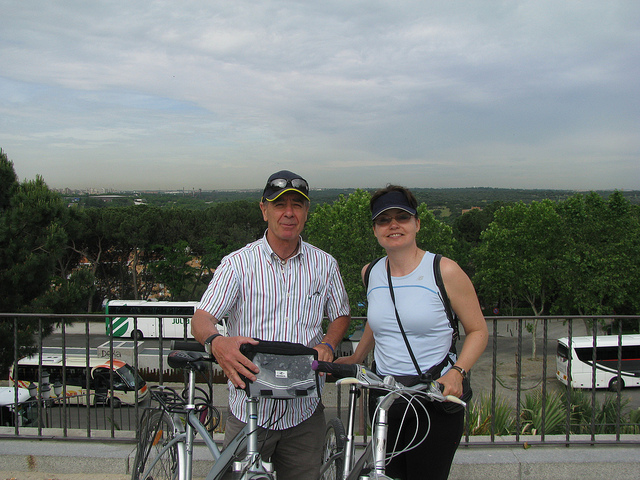Suckling pigs at the famous Restaurante Sobrino de Botin
Our next stop was on the Plaza Mayor, Madrid’s impressive main square, which measures 129 by 94 metres. Construction started in 1620 under the reign of King Philip III. Kaspar explained that the plaza was originally used as a bullring. The Casa de la Panaderia (“the Bakery”) anchors the square and houses various municipal offices and cultural organizations.

The Plaza Mayor in Madrid
Then Kaspar whisked me away and we cycled to the Puerta del Sol, Madrid’s other grand plaza and the heart of the city. This is one of Madrid’s busiest places and it is also home to Kilometer Zero, the hub of Spain’s network of radial roads. All road distances in the country are measured from here. The Puerta del Sol was originally one of the gates in Madrid’s medieval wall. From the 1600s to the 1800s this was the location of the city’s post office where all the couriers and news-hungry people congregated. The Old Post Office is now the office of the President of Madrid who governs the Autonomous Community of Madrid.

The famous bear statue on Madrid’s Puerta del Sol
The centre of the square is anchored by a Monument to Charles III. We stopped at the famous statue of the bear that is climbing a strawberry tree, the symbol of Madrid. The Puerta del Sol is the symbolic heart of Madrid, and has also become a gathering place for rallies and protest, including the protests against terrorism after the March 2004 bombings of the Atocha Railway Station.

One of the many impresive buildings on Madrid’s Calle de Alcala
Further north on the Calle de Alcala, Madrid’s longest street, we admired the imposing early 20th century architecture which features a variety of bank buildings. Through smaller streets we then cycled to the Literary District, El Barrio de las Letras. This area was where many famous writers, artists, scientists and politicians gathered. Some of the greats of Spanish literature lived in this neighbourhood including Miguel de Cervantes and Lope de Vega.

The Spanish Theatre of Madrid
The Plaza de Santa Ana is in the heart of the Literary District, anchored by the Spanish Theatre which features the names of literary greats like Tirso de Molina and Lope de Vega on its façade. Kaspar mentioned that Cervantes lived around the corner from here. Located in an elegant French-style edifice, the Madrid Reina Victoria Hotel used to be a department store and now is a magnet for after-work crowds who enjoy a cocktail on its rooftop terrace. Various tapas bars, restaurants and charming beer cellars flank this atmospheric square.

The Plaza de Santa Ana
Still inside the Barrio de las Letras, we cycled a bit further and stopped at the Casa del Abuelo. This historic Madrid restaurant is known for the best shrimp, prawns and sweet wine in the whole city. Kaspar and I settled in for a plate of breaded shrimp with a glass of local wine and started talking more about Kaspar’s biking tours. I asked my guide about his bike tours of the Camino de Santiago.

We took a little break in the Casa del Abuelo
Kaspar responded that about 30% of all travelers on the ancient St. James Way complete their pilgrimage by bicycle. His company offers various guided and self-guided tours, most of which start in Burgos and cover a distance of 500 km to Santiago de Compostela. Travellers cycle about 60 to 70 km a day, stay in comfortable 3 and 4 star hotels, get their luggage delivered and can ride in the support van if the get enough of the biking.

Another one of the tile paintings in Madrid, this one for San Miguel beer
Just recently Kaspar welcomed a group of 30 Irish students from Dublin who trekked 300 km by bicycle from Leon to Santiago. Recent tour groups have included groups from Venezuela, Mexico, the United States and on his last Camino tour group Kaspar even had a lady from Canada. The ancient Camino de Santiago has experienced a true renaissance in recent years, and it appears that cycling enthusiasts have discovered it as well.

Kilometre Zero on the Puerta del Sol, the centre of Spain’s road network
We slowly made our way back to Kaspar’s office near the Plaza de España. It was now early afternoon and I asked my trusted guide for his suggestions for the rest of the day. I was actually in the mood for a day trip out of the city, so Kaspar suggested that I take a bus to the ancient city of Segovia. I was looking forward to a little excursion out of Madrid.




